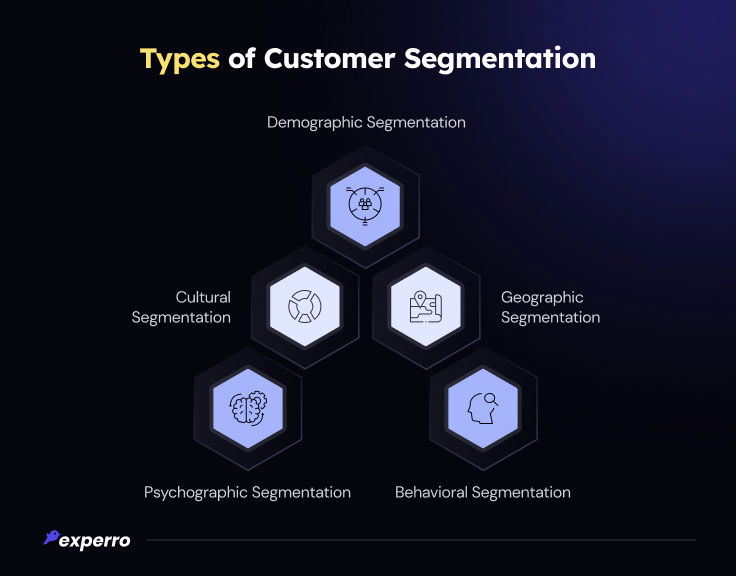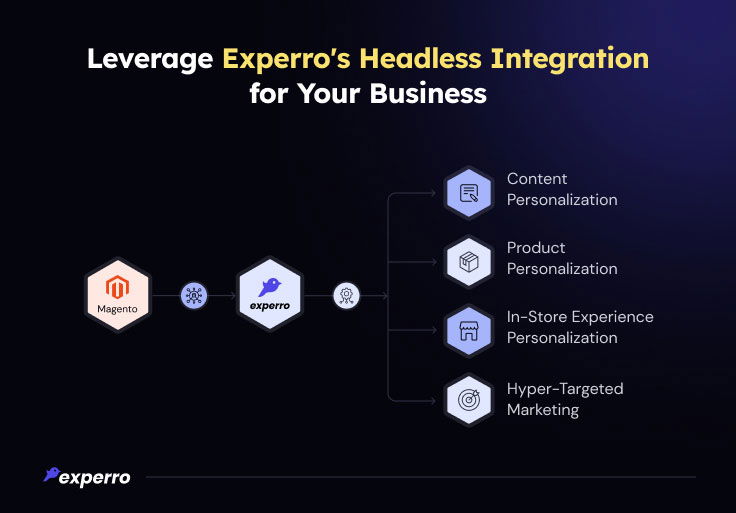How to Overcome Magento Customer Segmentation Challenges?

What’s Inside
- What Is Customer Segmentation?
- What Are the Types of Customer Segmentation?
- Where Do Magento Extensions Lack in Customer Segmentation?
- Experro’s Extraordinary Capabilities for Customer Segmentation
- Integrate your Magento site with Experro for hyper-targeted marketing initiatives!
- Conclusion
Key Takeaways
- Customer segmentation helps businesses tailor their targeted marketing strategies to meet the unique needs of different customer groups.
- Magento customer segmentation capabilities are limited, often requiring additional extensions and customization.
- Effective segmentation can enhance user engagement, improve customer satisfaction, and drive higher conversion rates.
- Experro provides an all-in-one solution for seamless Magento customer segmentation and product personalization, integrating effortlessly with the platform.
Have you ever felt frustrated because your Magento-based website’s customer segmentation capabilities are not enough?
Magento itself doesn't provide built-in customer segmentation features.
But using extensions for customer segmentation in Magento 2 can sometimes cause accuracy problems with customer segments.
The limitations of customer segmentation in Magento can hinder your marketing and sales strategies. Despite Magento’s segmentation personalization features, you might not achieve the aspired engagement figures.
Before diving deeper, let's explore what customer segmentation really means.
What Is Customer Segmentation?
Customer segmentation is the process of dividing a broad consumer market into sub-groups of consumers (known as segments).
By understanding these segments, businesses can tailor their marketing strategies to meet the unique needs and preferences of each group.
According to Notify Visitors’ research, a customer segmentation strategy can lead to a 50% rise in conversion rate.
Now, the question arises - How many types of customer segmentation are there?
What Are the Types of Customer Segmentation?
Mainly, there are 5 types of customer segmentation:

1. Demographic Segmentation
Demographic segmentation divides customers based on measurable statistics such as age, gender, income, level of education, and occupation.
By understanding the needs of different demographic groups, companies can create highly targeted campaigns and other promotions that resonate with them.
2. Geographic Segmentation
Geographic segmentation involves segmenting customer groups based on their physical location. It can range from countries and regions to cities and neighborhoods.
Companies can deliver localized marketing efforts and optimize their inventory and promotional strategies by focusing on geographic differences.
3. Cultural Segmentation
Cultural segmentation focuses on the cultural backgrounds and lifestyles of customers. This includes religion, ethnicity, social norms, and values.
Besides, businesses can create culturally relevant marketing campaigns by addressing the nuances of different customer groups.
4. Behavioral Segmentation
Behavioral segmentation is based on customer attributes, such as purchasing habits, product usage, and brand loyalty.
By understanding these patterns, businesses can optimize their marketing campaign efforts to encourage repeat purchases and enhance customer experience.
5. Psychographic Segmentation
Psychographic segmentation divides the market based on consumer lifestyles, interests, and personality traits.
This type of segmentation provides deeper insights into the motivation behind customer purchases.
By appealing to the specific interests and values of different customer groups, companies can create highly personalized marketing strategies. This drives higher engagement and conversion rates.
By implementing these segmentation strategies, businesses can boost product experience management.
Where Do Magento Extensions Lack in Customer Segmentation?
Yes, Magento eCommerce extensions offer customer segmentation capabilities, but its segmentation module fails to deliver precise targeting.
Magento 2 customer segmentation and personalization features provided by these extensions do not always boost engagement as expected.
While these extensions can help create Adobe customer groups, they don't address diverse needs effectively. Magento dynamic customer segmentation requires significant customization and technical expertise, which can raise costs and complexity.
Many registered users face problems with Magento customer segmentation, such as accuracy problems and costly maintenance.
In fact, Magento enterprise customer segmentation can lead to irrelevant results, making it difficult to optimize your sales approach.
The limitations of Adobe customer segmentation functionalities highlight the need for more robust solutions. Understanding these issues is crucial for businesses aiming to leverage Magento eCommerce customer segmentation effectively.
Since Magento doesn't provide built-in customer segmentation capabilities, it compels the entrepreneurs to look for additional extensions.
For example,
- Algolia for personalization functionality
- Nosto to understand customers’ browsing behavior
- Amasty for scalability
BUT, this approach can be complex and costly.
Experro’s Extraordinary Capabilities for Customer Segmentation
Experro is the all-in-one solution you need!
The platform’s headless Magento integration provides the ultimate customer segmentation capabilities.

It helps with content personalization, product personalization, and in-store experience personalization. This ensures a seamless and personalized experience for each customer.
To further enhance Magento customer segmentation, Experro allows users to customize rules in various areas:
- Event Data Segmentation: Customize rules to segment customers based on their interactions with events, such as product launches or sales.
- RFM Segmentation: Set up rules for Recency, Frequency, and Monetary (RFM) analysis to identify valuable customers.
- First-time Buyers: Create segments to distinguish and target customers making their first purchase.
- Loyal Customers: Customize segmentation to recognize and reward repeat buyers.
- Seasonal Shoppers: Establish rules to identify customers who shop during specific seasons or holidays.
- Price-sensitive Customers: Segment customers based on their responsiveness to price changes and discounts.
- Spend-based Segmentation: Set criteria to categorize customers by their spending habits.
- Channel Segmentation: Customize rules to segment customers based on their preferred shopping channels.
- Demographic Segmentation: Define segments using demographic data such as age, gender, location, and more.
Conclusion
In summary, Magento’s customer segmentation issues can hinder your sales and marketing strategies. Customer segmentation in Magento 2 requires additional extensions to meet diverse needs, which can increase costs and complexity.
And despite Magento 2 customer segmentation and personalization features, businesses may not achieve the desired engagement levels.
However, with our headless integration, you can combine content and product personalization with your existing Magento customer segmentation models.
For those seeking to overcome Magento segmentation challenges and optimize their sales approach, Experro provides an all-in-one platform that simplifies advanced customer segmentation and enhances Magento customer segmentation.
For more information about the integration with Experro to get the best product recommendations for your Magento site, connect with our experts.
FAQs


Pallavi Dadhich
09 August 2024Pallavi is an ambitious author known for her expertise in crafting compelling content across various domains. Beyond her professional pursuits, Pallavi is deeply passionate about continuous learning, often immersing herself in the latest industry trends. When not weaving words, she dedicates her time to mastering graphic design.